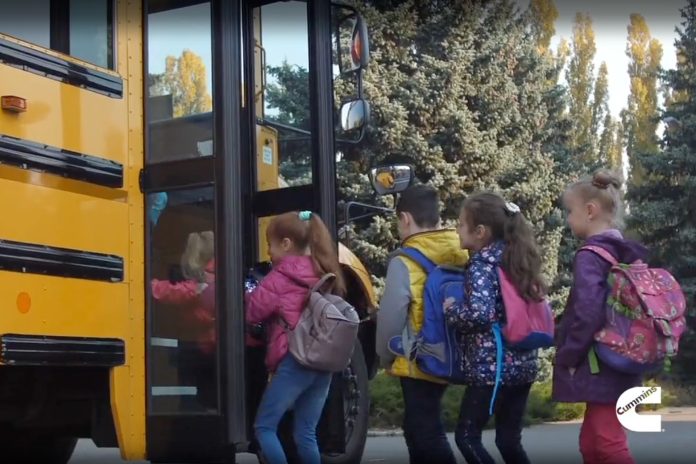In the age of the electric school bus, Cummins Inc. says it is not forgetting about school districts that need alternatives by offering the first fuel-agnostic engine platforms for medium- and heavy-duty commercial vehicles.
The popularity of the new engine designs is driven by a full-court press from industry and regulators to achieve zero emissions. Many school districts seek lower emissions via electric buses or other alternative fuels, as funding becomes available from different sources.
Cummins introduced on Feb. 14 a new line of fuel-agnostic engines to serve as a platform for multiple fuels. These platforms use an engine core with shared architecture, which may be used (with slight retrofit) for a variety of fuels: gasoline, diesel, propane, hydrogen, and others. Thus the engines are “fuel-agnostic.”
Related: Cummins to Acquire Meritor
These new engine platforms are designed from derived data from millions of diesel and natural gas engines already in use by existing Cummins customers. Today’s digital and connected technologies allow Cummins to extract insights specific to different engine duty cycles and leverage such data to design a reliable fuel-agnostic platform.
Schools Seek Clean Energy
As schools receive funding from federal, state and local resources, they are not only buying electric school buses but also alternative-fuel buses. The demand is present and has been at play for the past decade, as seen by over 22,000 propane school buses currently in service nationwide. These buses have engines that burn cleaner, with very low and favorable emissions from exhaust gases.
In 2018, the Leander Independent School District near Austin, Texas, bought 24 new buses powered and equipped with a propane fuel system, certified by the EPA and the California Air Resources Board. Those buses are some of the cleanest burning drives available and produce low nitrogen oxide (NOx) emissions at 0.05g NOx, which is 75 percent cleaner than the EPA emissions standard and any other offering on the market. They were funded with $740,000 from the Texas Commission on Environmental Quality.
“The savings achieved with our propane buses go back into our school district general funds,” said Ann Hatton, the district’s director of transportation. “I am pleased that our choice of an alternative fuel can help put money back into the classroom.”
When compared with the diesel buses they replaced, the district’s 127 propane buses reduce harmful NOx emissions by more than 130,000 pounds and particulate matter by almost 3,000 pounds annually.
Hatton added that the district’s technicians benefit from the lack of exhaust fumes in the maintenance, noting that drivers also appreciate the propane buses’ “get up and go” performance.
Meanwhile, The Livonia Public Schools in Michigan added 22 Blue Bird propane buses to its fleet with funding received from the state’s Department of Environment, Great Lakes, and Energy (EGLE). The district received nearly $845,000 through EGLE’s Fuel Transformation Program to purchase clean, cost-effective propane school buses that began operation at the start of the 2020-2021 school year.
Other districts are following suit as well. Just last year, six South Dakota school districts (Brookings, Gayville-Volin, Harrisburg, Lennox, Madison Central and Yankton) received South Dakota’s Department of Environment & Natural Resources (DENR) funding to purchase emissions-reducing propane autogas school buses. The districts, like Livonia, sought buses that emit fewer greenhouse gases, smog-producing hydrocarbons and nitrogen oxides compared with the diesel buses replaced, and propane operating costs are significantly lower.
Destination Zero
The term used by Cummins describes the company’s goals for engine production over the next 30 years.
Fuel-agnostic engines, Cummins posits, are an essential element of the company’s strategy to reduce greenhouse gas (GHG) and air quality impacts to reach net-zero emissions by 2050. The intent is to serve stakeholders with sustainability.
By 2030, Cummins plans to reduce Scope 3 absolute lifetime greenhouse gas (GHG) emissions from new products by 25 percent. Cummins also plans to partner with customers to reduce Scope 3 GHG emissions by 55 million metric tons.
“Cummins is innovating at every level of the company to find new ways of working that use fewer of the world’s resources and the engine business is at the center of this exciting innovation,” said Srikanth Padmanabhan, a vice president at Cummins and president of the company’s engine business. “We know that our planet cannot wait for the perfect solution to happen. Instead, our approach must be a combined effort of using zero-emissions power where it is available and using cleaner power where it is not. The planet cannot afford for us to hit pause in the meantime.”
Right Fuel for the Right Application
Depending on the desired fuel, each powertrain must be certified for that fuel and vehicle, according to fuel-specific requirements — mostly at the engine’s “top end.” The desired fuel must be specified at the point of sale to certify the engine and bus.
Each engine within a platform portfolio, however, will be optimized to run on a specific fuel type. For example, Cummins eventually plans to use its B6.7 platform, the most used engine in the school bus industry, with diesel, natural gas, gasoline, propane, and hydrogen options. The different fuel platforms will be launched incrementally. For the B platform, gasoline will be the first fuel launched.
According to Cummins, different applications require different technologies. Some applications such as hydrogen require adequate infrastructure support – much like battery electric. It is expected that in the future, infrastructure will be more prevalent with charging stations and refueling stations for electric and hydrogen, though the latter as of yet has not shown promise for school bus duty cycles. Cummins officials said the company is following the portfolio development according to what platforms and supporting infrastructure are present. Cummins currently offers both diesel and natural gas engines in the school bus market. They also have a battery-electric available in Blue Bird buses.
Not all fuels platforms will immediately appeal to school buses. School bus operation is intermittent and not as continuous as long-haul trucking. Because it is intermittent, not all fuels or power are ideal for it. Neither are the economics of power consumption.
However, low to zero emissions always are a key benefit, and that is a worthy goal of many districts and the municipalities and governments that usually fund such power trains. Schools will be able to specify the version of Cummins engine, according to their desires.
Related: New Legislation Funds Major Deployment of Zero and Low-Emissions School Buses
Related: Proposed California Education Budget Includes 3-Year, $1.5B Electric School Bus Program
Related: Senators Continue Call for Increased Zero-Emission School Bus Funding
Supportability
An adjunct advantage of fuel-agnostic engine platforms is parts support. The engine configurations share common parts across many fuel types. The engine versions derive from a common base engine, with a high degree of parts commonality. The lower portion of the engine below the engine head, shares similar components across types. Above the head gasket may have different components for different fuel types.
The innovative design approach will be applied across the company’s engine portfolios.
“This is a new way of designing and developing lower-emission, internal-combustion powertrains that meet the unique needs of the transportation industry while leveraging the benefits of a common product architecture and footprint where possible,” said Jonathon White, vice president of engineering for Cummin’s engine business. “This unique technology approach will allow end-users to more seamlessly pick the right powertrain for their application with the lowest CO2 impact.”
Parts commonality is economical and not only strengthens the opportunity to integrate a variety of fuel types across the same truck chassis, but it also allows engines to share part inventories. In addition to fuel and parts advantage, the new engines make it easier to train technicians.
















